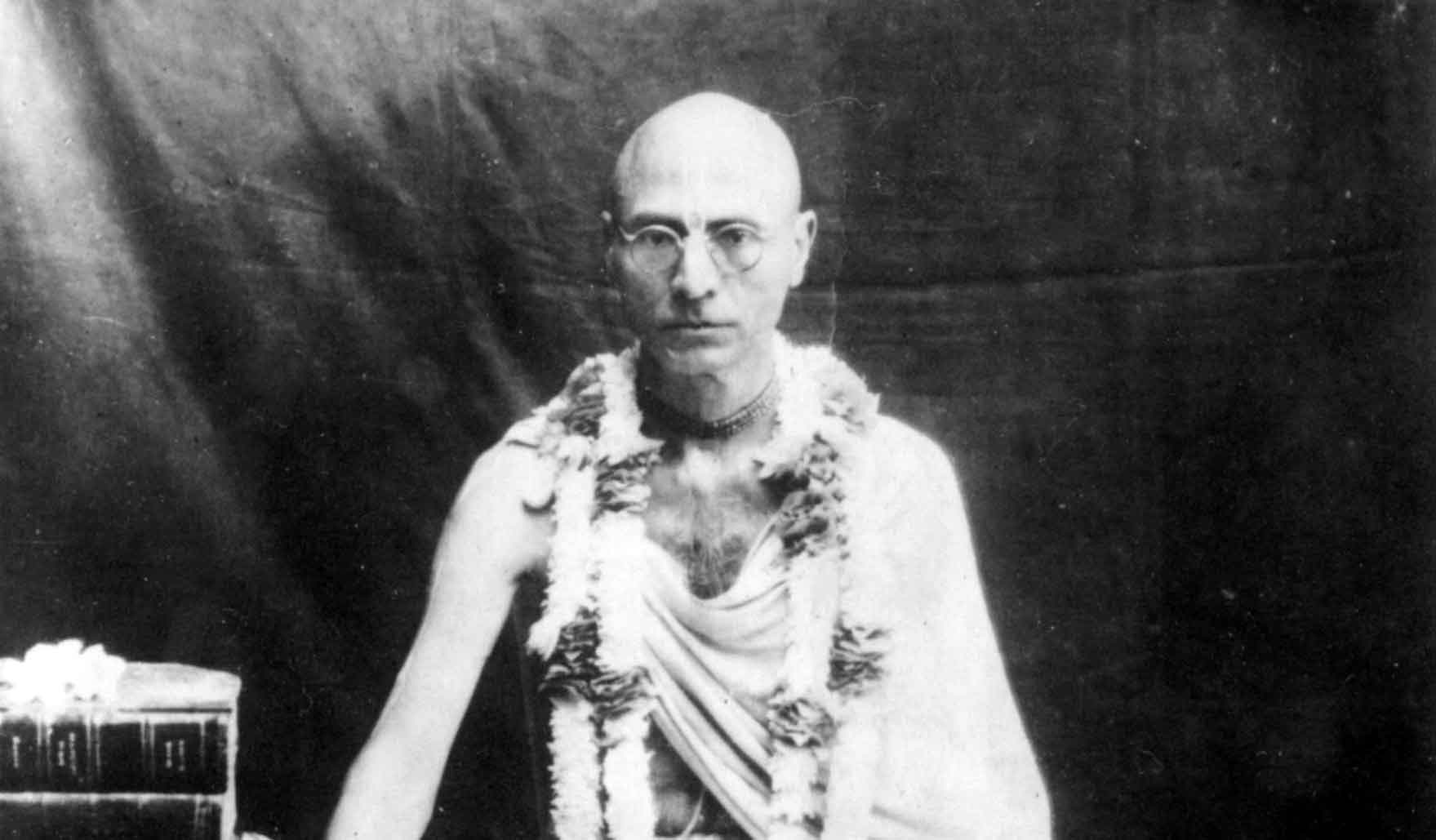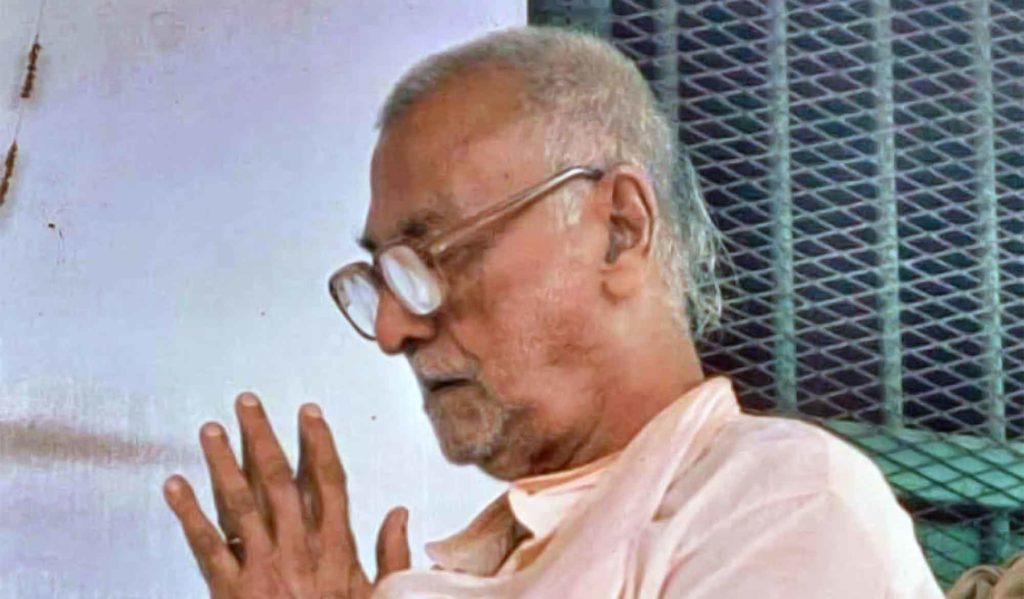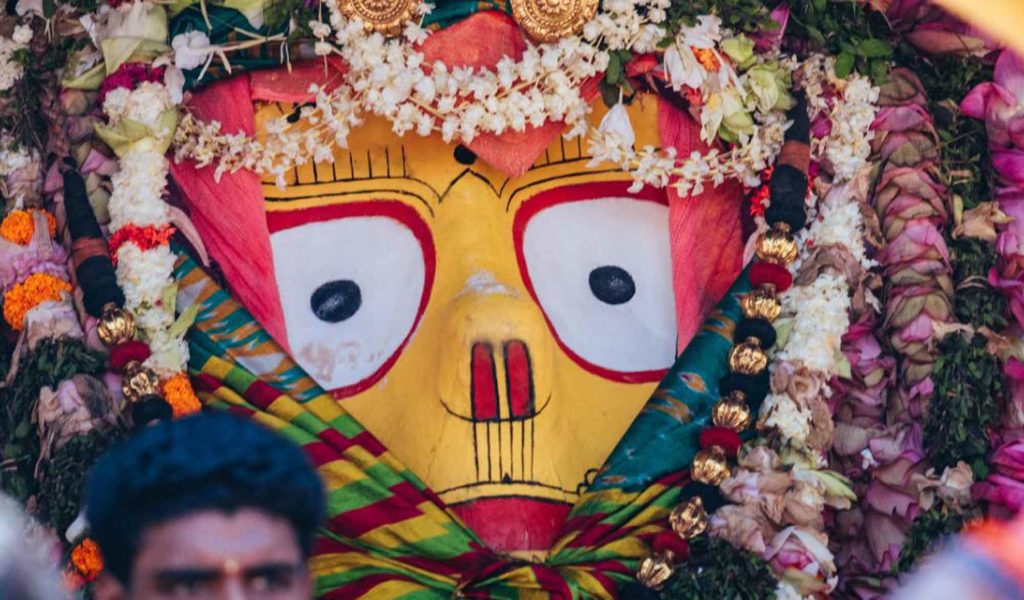Overview
The following lecture was given by Śrīla Śrīdhara Mahārāja in the evening of the 24th December 1944 at Śrī Caitanya Maṭha, Māyāpura, and was published in Dainik Nadīyā Prakāśa on the occasion of the observance of Śrīla Bhaktisiddhānta Sarasvatī Ṭhākura’s disappearance. This article was translated by Swami B.V. Giri and Sanātana Dāsa.
nijābhiṣṭha-samāsliṣṭha-kṛṣṇānukula-śilanam
diśatām parama-śreṣṭha-gaura-preṣṭhāya te namaḥ
namaḥ oṁ viṣṇu-pādāya kṛṣṇa-preṣṭhāya bhūtale
śrīmate bhaktisiddhānta sarasvatīti nāmine
vāñcā-kalpatarubhyaś ca kṛpā-sindhubhya eva ca
patitānāṁ pāvanebhyo vaiṣṇavebhyo namo namaḥ
anarpita-carīṁ cirāt karuṇayāvatīrṇaḥ kalau
samarpayitum unnatojjvala-rasāṁ sva-bhakti-śriyam
hariḥ puraṭa-sundara-dyuti-kadamba-sandīpitaḥ
sadā hṛdaya-kandare sphuratu vaḥ śacī-nandanaḥ
The supremely worshippable Śrīla Prabhupāda has delivered the message of Śrīman Mahāprabhu to this world by accepting the Brahmā-Vyāsa-Madhva sampradāya. Śrī-Brahmā-Rudra-Kumāra – these four bona-fide sampradāyas have eternally invoked inexhaustible auspiciousness by appearing in this world. These four śrauta-sampradāyas (lineages based on the descending revelation of knowledge) are eternally manifest. All of them have accepted the method of śruti (divine knowledge which is heard) as the principal pramāṇa (evidence). Apart from these four śrauta-sampradāyas there are many other sampradāyas in Bhārata-varṣa who claim to be srauta-sampradāyas, yet they are not surrendered to the medium of śruti and propagate individual opinions that are actually against it.
Even amongst the four śrauta-sampradāyas there are conceptual differences and uniqueness in their specific approach towards bhajana. The service of Bhagavān performed within each of the transcendental rasas also has individual characteristics and gradation.
yāra yei bhāva sei haya sarvottama
taṭa-stha hañā vicārile, āche tara-tama
“Whatever the bhāva a devotee feels for the Lord is the best for him. If we consider it from a neutral perspective there are gradations.” – Cc. Madhya-līlā 8.83
Although each philosophy and bhajana of each sampradāya is considered to be the best by them, still, if we judge from an impartial standpoint, there are gradations and differences. Judging without prejudice one comes to realise that whatever Śrī Caitanyadeva has contributed philosophically by accepting the Brahmā-Madhva sampradāya should be considered to be the highest. The teachings and conclusions of the Śrīmad Bhāgavatam, the crest-jewel of all the scriptures and the natural commentary on the Vedanta, has been delivered to this world by Śrīman Mahāprabhu and Śrīla Prabhupāda (Bhaktisiddhānta Sarasvatī Ṭhākura). During the manifestation of Brahmā, the true message of the Bhāgavata was not revealed and was also hidden during the time of Śrīman Madhvācārya. Śrīman Mahāprabhu and Prabhupāda have distributed this very message of the Bhāgavata in a more revealed way to the world.
It may be asked whether the message of the Bhāgavata was present in this world before Śrīman Mahāprabhu. Is the message of Mahāprabhu and Prabhupāda something new? Are there differences between the transcendental ācāryas? The answer to all these queries is this – all the ācāryas are fundamentally the same. During the time of different ācāryas, the same singular principal either contracts or expands when revealed according to Kṛṣṇa’s desire. Among the ācāryas there is no ignorance or difference of opinion. Yet as regards the revelation of philosophy there are gradations.
The knowledge of the Śrīmad Bhāgavatam was preached profusely during the time of Mahāprabhu. It was seen that Brahmā, in spite of being the original spiritual master (ādi-guru), pretended to be in illusion during the pastimes of Kṛṣṇa. The verse, muhyanti yat-sūryayaḥ instructs us that even the demigods become bewildered in trying to understand supreme knowledge. In spite of Brahmā being eternally liberated, he performs such pastimes in order to delude the demoniac. Whatever illusion we are subject to is not the same as Brahmā’s.
In spite of verbally accepting allegiance to Śrīla Vyāsadeva, various schools of māyāvādīs, karmīs and yogīs have established their own interpretations. Even ācārya Śaṅkara, although declaring Śrīla Vyāsadeva to be his guru, had the audacity to establish the concept of illusion (māyā). Śrīman Madhvācārya has established the natural siddhānta of Śrī Vyāsadeva. Śrīman Madhvācārya accepted the sac-cid-ānanda form of Śrī Kṛṣṇa and preached that His worship is the topmost. In other bona-fide sampradāyas Kṛṣṇa is not accepted as the only object of worship. Śrīman Mahāprabhu accepted the sampradāya of Śrīman Madhvācārya based on service to the Supreme, namely the philosophy of eternal service to the sac-cid-ānanda form of Śrī Kṛṣṇa. Because it declares the worship of Śrī Kṛṣṇa to be the topmost, Śrīman Mahāprabhu accepted this sampradāya. He accepted the conception of śakti and service to the Vaiṣṇavas from Śrī Rāmānujācārya. He also accepted Viṣṇu-Svāmī’s rāga-bhajana and the Dvaitādvaita-siddhānta of the Nimbārka sampradāya.
Whatever the ācāryas of the four sampradāyas came to distribute to the world had some elements that were incomplete. It is not an exaggeration to say that the supreme position of the worship of Rādhā-Govinda, which Prabhupāda revealed to the world by taking the essence of the four sampradāyas following in the footsteps of Mahāprabhu, is unparalleled. The teachings that the aforementioned eternal ācāryas of the four sampradāyas have themselves revealed could be said to be partial revelation, while the teachings of the sun-like ācārya Śrīla Prabhupāda can be said to be their very source.
ākāśādira guṇa yena para-para bhūte
dui-tina krame bāḍe pañca pṛthivīte
“The qualities in the material elements – sky, air, fire, water and earth – increase one after another by a gradual process of one, two and three, and at the last stage, in the element earth, all five qualities are completely visible.” – Cc. Madhya-līlā 8.87
Just as when compared to other elements, earth is unique because it is the only element where all five elements can be seen combined together, so also various rasas like śānta, dāsya etc. progressively advance to the confluence of madhura-rasa. Similarly, the lion-like ācārya (ācārya-keśarī) Śrīla Prabhupāda is the confluence of the quintessential teachings of the ācāryas. Śrīla Prabhupāda revealed and introduced service to the four ācāryas in Śrī Caitanya Maṭha and thus preserved their dignity and most significantly established his own unique position. Similarly, his conduct and preaching also manifested this uniqueness.
Service to the Supreme as taught by all other ācāryas such as Rāmānuja, Nimbārka etc. are all included within the teachings of Śrīla Prabhupāda. The supreme miracle of the service of Śrī Rādhā-Govinda, as manifested by Śrīla Prabhupāda, contains the teachings of all other ācāryas within it. Presently it is observed that the concepts and conduct of ācāryas of other sampradāyas lack inner substance and only an external covering exists. If the spirit of universal service to the Supreme Absolute Truth, as shown by the supremely worshipable Śrīla Prabhupāda, is accepted by other sampradāyas, then they will also be fulfilling their objective and their deficiency will turn into fulfilment.
We can see that presently all sampradāyas are more or less, knowingly or unknowingly, accepting the teachings of Śrīla Prabhupāda. Even if a fraction of what Śrīla Prabhupāda taught remains in this world, then the world would be supremely fortunate. Śrīla Prabhupāda did not subscribe to the conception of solitary bhajana or the idea of renouncing the world due to considering it to be illusory. He taught that we should see matter as having its true position as the object of enjoyment of Kṛṣṇa and accordingly accept whatever is favourable. He never said that we should practice devotion to God on a part time basis and be involved in other materialistic activities during the remaining time. He preached complete service to the Lord. He has spoken about performing Bhāgavata-bhajana with yukta-vairāgya for all time, place and circumstance. Simply renouncing our connection with this world is not the purpose of Prabhupāda’s instructions. Instead of channeling material energy for Kṛṣṇa’s service, if one adopts the path of renouncing matter in fear of becoming contaminated by it, this will have a negative impact on our hari-bhajana. Śrīla Prabhupāda has taught us the practice of engaging everything pertaining to this world in the service of Kṛṣṇa. This is the unique position of Śrīla Prabhupāda. Śrīla Prabhupāda has spoken about the cultivation of devotion to Kṛṣṇa or activities dovetailed towards the immutable spiritual plane. But he has not prescribed endeavours in mundane perishable activities. Endeavours in such mundane activities cannot be considered as cultivation of devotion to Kṛṣṇa.
If we try to understand the teachings of Prabhupāda through our own individual mental speculation we will ultimately be deceived. Like the demon Rakta-bīja, we are constantly developing a multitude of fresh anarthas (1). If we approach Prabhupāda’s teachings with various mental concoctions we will be unable to harmonise them. We will never be able to understand the harmonizing aspect of Prabhupāda’s teachings through our own individual endeavours.
Many ācāryas who appeared before Mahāprabhu accepted Him. Śrīmad Advaita Prabhu, in spite of being older in age, served Mahāprabhu. The defect within the other sampradāyas is that they accept Viṣṇu, Rāma and Kṛṣṇa but they do not accept Mahāprabhu. As regards spiritual matters, while analysing topics relating to the Absolute, there is no necessity of judging on the basis of historical antecedent and precedent.
Whether it is in the past, present or future, according to the extent by which a place or a sampradāya deviates from the teachings of Śrīla Prabhupāda, we should keep a distance from them.
All of you kindly bless me that I have unflinching faith in the devotional siddhānta of Śrīla Prabhupāda.
vāñcā-kalpatarubhyaś ca kṛpā-sindhubhya eva ca
patitānāṁ pāvanebhyo vaiṣṇavebhyo namo namaḥ
(1) Rakta-bīja was a demon mentioned in the Markaṇḍeya Purāṇa who was given a boon by Brahmā that whenever a drop of his blood fell upon the earth, another Rakta-bīja, as strong as the original, would manifest on the spot. He was finally killed by Goddess Kālī who drank all his blood and devoured all the duplicate Rakta-bījas.)
Related Articles
- The True Spirit of Separation by Śrīla Bhakti Pramoda Purī Gosvāmī
- Śrīla Swami Mahārāja Attains the Dust of Vraja by Śrīla Bhakti Pramoda Purī Gosvāmī
- The Disappearance of Śrīla Śrīdhara Mahārāja by Śrīla Bhakti Pramoda Purī Gosvāmī
- Who is Qualified to Succeed the Ācārya? by Śrīla Bhakti Rakṣaka Śrīdhara Deva Gosvāmī
- Śrīla Sarasvatī Ṭhākura’s Disappearance Day by Śrīla Bhakti Rakṣaka Śrīdhara Deva Gosvāmī
- His Last Instructions by Śrīla Bhakti Gaurava Narasiṅgha Mahārāja
- The Prākṛta and Aprākṛta-līlā of Śrī Guru by Śrīla Bhakti Gaurava Narasiṅgha Mahārāja
- Śrīla Prabhupāda’s Antya-līlā by Śrīla Bhakti Gaurava Narasiṅgha Mahārāja
- Śrīla Sarasvatī Ṭhākura’s Disappearance Day by Śrīla Bhakti Gaurava Narasiṅgha Mahārāja
- Śrī Jagannātha Deva Shook the Heaven and the Earth by Śrīla Bhakti Gaurava Narasiṅgha Mahārāja
- After the Disappearance of Śrī Guru by Śrīla Bhakti Gaurava Narasiṅgha Mahārāja
- A Nourishing and Compassionate Nature by Śrīla Bhakti Kiśora Āraṇya Mahārāja
- The Compassionate Nature of Śrī Guru by Śrīla Bhakti Kiśora Āraṇya Mahārāja
- Hope For The Hopeless by Śrīla Bhakti Kiśora Āraṇya Mahārāja
- The Disappearance of Śrīla Bhakti Gaurava Narasiṅgha Mahārāja by Swami B.V. Giri
Further Reading
Prema Dhāma Deva Stotram with the Narasiṅgha Sevaka Commentary – Verses 61-65
In verses 61 to 65 of 'Prema Dhāma Deva Stotram', Śrīla Śrīdhara Mahārāja narrates the pastime of Śrī Caitanya at Caṭaka Parvata In Purī and explains how the scriptures produced by Brahmā and Śiva are ultimately searching for the personality of Mahāprabhu who is merciful too all jīvas, no matter what their social position.
Prabhupāda Śrīla Sarasvatī Ṭhākura’s Visit to Ayodhyā
With the forthcoming observance of Śrī Rāma Navamī, we present 'Prabhupāda Śrīla Sarasvatī Ṭhākura’s Visit to Ayodhyā' written by Śrīla Bhaktisiddhānta Sarasvatī Ṭhākura Prabhupāda from The Gaudīyā magazine, Vol 3. Issue 21/ In December 1924, after visiting Benares and Prāyāga, Sarasvatī Ṭhākura visited the birth-site of Śrī Rāmācandra in Ayodhyā.
Śaraṇāgati – The Only Path to Auspiciousness
In this article, 'Śaraṇāgati - The Only Path to Auspiciousness', Dhīra Lalitā Dāsī analyses the process of śaraṇāgati (surrender) beginning with śraddhā (faith). She also discusses the role of śāstra and the Vaiṣṇava in connection with surrender.
Ātma Samīkṣā – The Value of Introspection
In this article, "Ātma Samīkṣā – The Value of Introspection" Kalki Dāsa highlights the importance of introspection in the life of a devotee and especially in relation to the worldly environment that surrounds us. He also explains how transcendental sound influences our capacity to introspect.
Prema Dhāma Deva Stotram with the Narasiṅgha Sevaka Commentary – Verses 61-65
In verses 61 to 65 of 'Prema Dhāma Deva Stotram', Śrīla Śrīdhara Mahārāja narrates the pastime of Śrī Caitanya at Caṭaka Parvata In Purī and explains how the scriptures produced by Brahmā and Śiva are ultimately searching for the personality of Mahāprabhu who is merciful too all jīvas, no matter what their social position.
Prabhupāda Śrīla Sarasvatī Ṭhākura’s Visit to Ayodhyā
With the forthcoming observance of Śrī Rāma Navamī, we present 'Prabhupāda Śrīla Sarasvatī Ṭhākura’s Visit to Ayodhyā' written by Śrīla Bhaktisiddhānta Sarasvatī Ṭhākura Prabhupāda from The Gaudīyā magazine, Vol 3. Issue 21/ In December 1924, after visiting Benares and Prāyāga, Sarasvatī Ṭhākura visited the birth-site of Śrī Rāmācandra in Ayodhyā.
Śaraṇāgati – The Only Path to Auspiciousness
In this article, 'Śaraṇāgati - The Only Path to Auspiciousness', Dhīra Lalitā Dāsī analyses the process of śaraṇāgati (surrender) beginning with śraddhā (faith). She also discusses the role of śāstra and the Vaiṣṇava in connection with surrender.
Ātma Samīkṣā – The Value of Introspection
In this article, "Ātma Samīkṣā – The Value of Introspection" Kalki Dāsa highlights the importance of introspection in the life of a devotee and especially in relation to the worldly environment that surrounds us. He also explains how transcendental sound influences our capacity to introspect.








